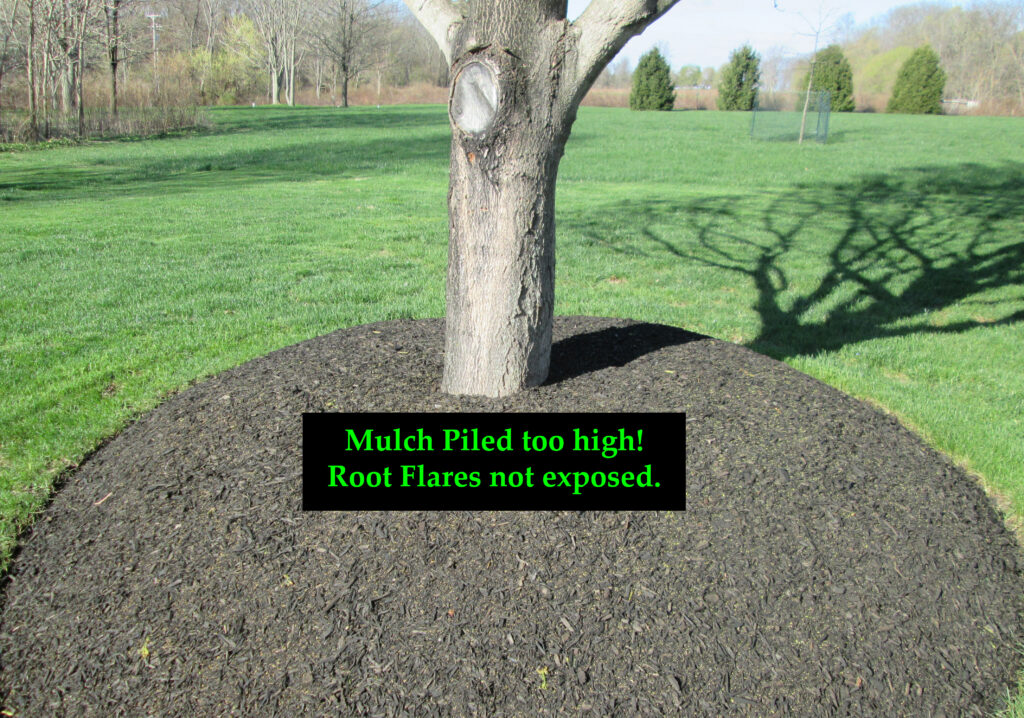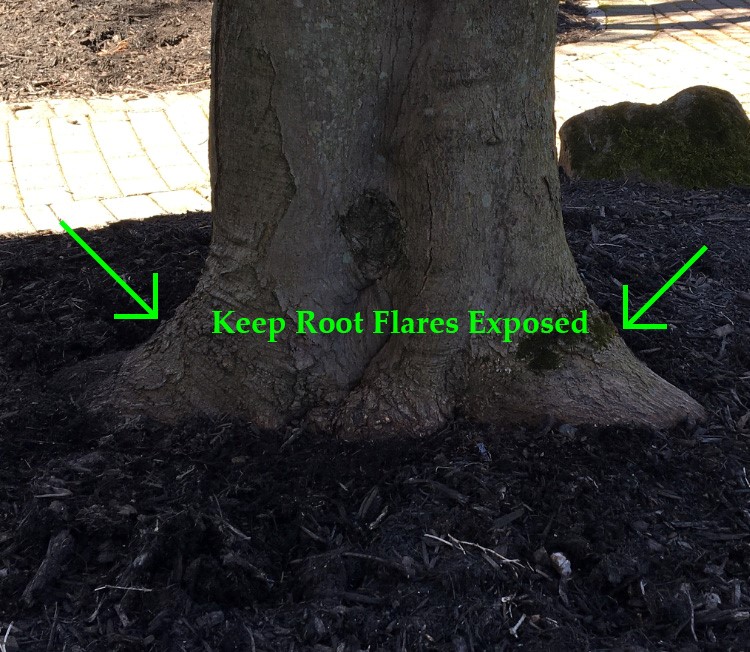Last Updated on May 3, 2025
To mulch or not to mulch: that is the question. Simply put, mulching your landscape is a good thing. But…having too much of a good thing (mulch) can be bad.
Mulching Recommendations
There are a few common reasons we mulch our landscape beds, it makes our yard look great, it helps reduce weeds, and proper mulching can benefit landscape plants. Regardless of the reason, you want to follow a few recommendations to avoid negative impacts on your landscape plants. In general, mulch should be maintained at a depth of 3 inches. If you already exceed 3 inches and are planning to add another layer this year, we recommend removing some of the existing mulch before adding another layer to help maintain the 3-inch depth level. Avoid piling mulch high on plant trunks and stems, keep the mulch away from the bases and be sure the root flare is visible. Piling mulch too high on plants is a very common mistake that has serious consequences to the health of your plants. We discuss this in more detail later in the blog.
Types of Mulch
There are two types of mulch for landscapes. Organic and inorganic. Organic mulch is what we are all probably used to seeing landscape professionals apply to the landscape beds. You know, the brown, black, and sometimes red stuff. These types of mulch are basically ground up trees and shrubs and other organic matter. Some people may elect to use chopped up leaves or grass from the lawn mower, and others may use wood chips. The inorganic mulch would be plastic or rubber mulch, stones and rocks, etc.
Benefits of Mulching your Landscape Beds
There are many benefits to having organic mulch applied to your landscape. One benefit is keeping the weeds in the beds to a minimum. However, the key here is to be sure that the areas being mulched are free of weeds before applying, otherwise they will keep growing until they poke through. You may have a nicely mulched landscape today, and if the weeds were not taken care of prior to the installation, next week you will have beds dotted with weeds. The weeds will likely be more noticeable coming up through the new mulch so you may feel like you wasted your money. To help reduce weeds, you can apply a pre-emergent control to your landscape beds, learn more by following this link to our landscape bed pre-emergent blog.
Another benefit is mulch helps retain moisture. This is especially helpful if you do not have irrigation in your landscape beds. If the beds were bare and it rained, the water would penetrate the ground very quickly or run off before the ground can take it in. Mulch absorbs that moisture and slowly seeps into the soil, allowing the plants to take it in. It acts kind of like a sponge. In addition, to retaining moisture, mulch also helps regulate temperature in the summer and winter.
One more benefit to mulching your landscape is that when the mulch breaks down, it is putting nutrient-rich organic matter back into the soil. This is especially true if you elect to use chopped up leaves for mulch. Leaves contain natural nitrogen and other beneficial nutrients that can be recycled back into the soil.
Finally, a freshly mulched landscape is very appealing to look at. It is like laying down new carpeting or a floor. If you’re looking to sell your home, it might not be a bad idea to put down a fresh layer of mulch. Same thing if you’re having a graduation party, wedding, or a big birthday party.
Problems with Over-Mulching
Now, let’s talk about what NOT to do when mulching your landscape beds. The first would be what the industry calls ‘volcano mulching’. This is when mulch is piled so high and tight up against a tree that it looks like a volcano. Literally. This is very bad for the tree!
Trees exchange oxygen at the base, and if the mulch is piled too high, the tree will suffocate. You may not see results from that suffocation early, but over the years the tree will slowly decline. At that point, the damage is done. Trees have a natural flare at the bottom, almost resembling a bell-bottom. This is that area that needs to be exposed. If your tree looks like a telephone pole sticking out of the ground, you have too much mulch (see photo above). In addition to the lack of oxygen exchanged, mulch piled high on tree bark can also promote disease and cause the bark to rot. For more information on the potential harms of over-mulching, here is a link to an article by Rutgers University titled Problems with Over-Mulching Trees and Shrubs.
The same rule of thumb applies to woody shrubs, such as hollies, boxwoods, rhododendrons, and laurels. Woody plants have a single stem that comes out of the ground and then it branches out to its form. That stem needs to be visible. In other words, if you cannot see the stem or if some of the lower branches are covered, you might have too much mulch. Not only will it likely suffocate the plants, but the continued moisture that is on the bark will cause it to rot, and possibly girdle it and die.
Conclusion
Mulch is a beautiful thing when applied correctly but can also kill your plants when done the wrong way. If you have any questions about mulching your landscape, please feel free to contact us if you live in our service area.



